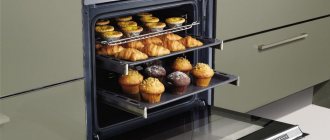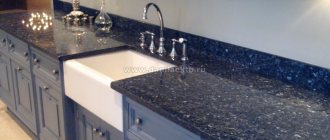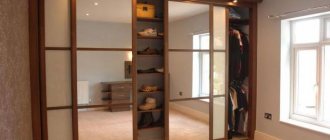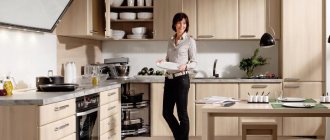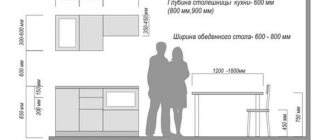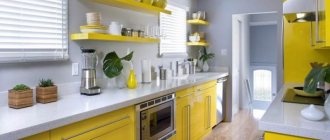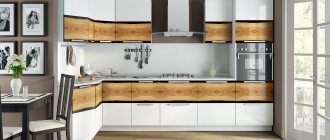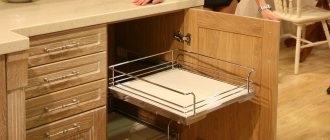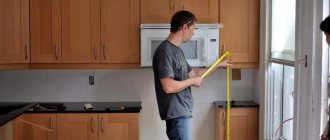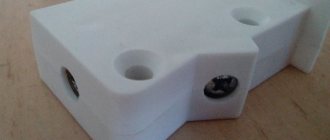Standard oven sizes
The external dimensions of a standard oven, both electric and gas, must correspond to the dimensions of the kitchen unit. The width of most models, like the height, is 60 cm, and their depth ranges from 54 to 58 cm.
The internal volume of the oven depends not only on external characteristics, but also on the number of functions: say, a cabinet without a microwave will have a larger volume than a model with a microwave of the same dimensions.
An example of a standard oven is the most popular electric oven in the Hausdorf online store, Asko OCS8664S: width and height - 60 cm, and depth - 55 cm. It comes with installation instructions, which indicate the dimensions of the niche for embedding, requirements for the location of the socket and ventilation.
The most popular standard gas oven Electrolux EOG92102CX has the same width and height, and the depth is 57 cm.
Don't believe everything that is written
I continue the story. I picked up an acceptable oven model at a hardware store. The description says the dimensions of the oven are 600×520×600 (W×D×H). What suited me very much was the depth of 520 mm. Ovens with a depth of 600 mm did not fit into the kitchen row.
However, according to this description, the situation with the niche for the oven is not at all clear. The width is 600 mm, refers to the dimensions of the front panel of the oven and nothing is said about the required niche for its installation.
And then the fun began. When trying to find the required niche dimensions for this oven, I constantly came across only one size, the niche should be 580x525x560 (WxDxH). What is clear is that it does not fit into a standard oven table with a width of 600 mm, with a niche of 568 mm (calculation above).
The data found raised obvious doubts. And so it turned out. I found the original PDF instructions for operating the oven I chose. It turned out that this model can fit (built into a niche with minimum dimensions of 555x525x598 (WxDxH), and the front panel has dimensions of 595x595 mm.
This means that the front panel of the oven will fit perfectly when built into the walls of a cabinet-table with dimensions of a width of 600 mm.
In the photo I showed the name of this oven. And instead of making a conclusion, don’t believe everything they write, even check the store consultant, preferably with your own tape measure.
An example of attaching an oven to a cabinet
Large ovens
Models with a width of about 90 cm are considered large; the height and depth in such cases are standard: about 50 and 55 cm, respectively. The chamber volume is from 80 l, most often it is 110-120 l. Thanks to this, you can cook whole poultry and fish, bake desserts for the holiday in one step.
Some manufacturers, for example, Wolf, make the oven more spacious due to the height - their models are 72x75x60 cm. They also produce double appliances, the total volume of which is more than 200 liters.
Style
Projects with built-in appliances are often created for minimalist interiors and industrial-style spaces. However, there are no restrictions on the use of this technique in classic spaces, as well as in country or Provence style kitchens. Manufacturers of household appliances have made sure that anyone, regardless of their ideas about beauty and convenience, can realize their ideas. There are many antique-style models on the market. But it’s still worth recognizing that in a modern kitchen, high-tech “rules the roost”: this applies to both the prevailing style and the technology of the equipment.
Small ovens
Compact models, as a rule, are reduced due to their height - it is about 45 cm, while the width and depth remain standard: 60 and 55 cm, respectively. The volume of such devices is 45-50 liters. For example, Gorenje BCM547ORAW has the following parameters: HxWxD: 45.5x59.5x54.6 cm.
Narrow ovens are also produced. These are quite rare models, their width is 45 cm, the height and depth are standard - 60 and 55 cm, respectively. For example, Korting OKB 7931 CMX: 59.5x45x56.5 cm.
A little about the burners
Heaters for electrical panels are divided into the following options:
- Insulated design - requires a certain diameter of cookware.
- Double expansion - they consist of two symmetrical circles; you can cook in dishes of different diameters.
- Three different diameters - suitable size cookware is installed.
- Oval and rectangular in shape - designed for using non-standard sized cookware.
- Design Domino is a modular principle, the hob is made up of rectangular components for various purposes, up to 4 options: grill, deep fryer, steamer or exotic Teppan yaki, which translated from Japanese means fried on a steel sheet.
For fans of culinary delights, induction panels with five burners are suitable, which will allow you to prepare a variety of food. Each user chooses an option that is acceptable to him.
Ovens of non-standard height
Among the models whose sizes differ from the standard ones, several categories can be distinguished.
Ovens are small in height, from 30 to 45 cm. These are devices with a volume of up to 50 liters, among which are models with a microwave.
Our catalog also includes models of smaller height, convenient for embedding in a box in a small kitchen - such as De Dietrich DOP1199X with a height of 38 cm.
This category also includes free-standing cabinets, of which much less is produced than built-in ones. Among them, for example, is the small tabletop model Ilve A645LZE4 with a volume of 35 liters and a height of 45 cm.
Tall ovens from 60 cm or more
- most often large-volume semi-professional devices. Thus, Wolf ICBSO30PM/S/PH is 72 cm high and has a volume of 125 liters, and its width exceeds the standard values - it is 76 cm.
In this group, double devices with an additional oven with a total volume of about 250 liters and a height of 130 cm stand out - like the Wolf ICBDO30CM/B with 10 operating modes.
Among them there is also such a rarity as free-standing ovens - for example, the unique model Ilve 200B-MMP graphite, 90 cm high, with two chambers with a volume of 73 liters.
Gas or electric - advantages and disadvantages
The gas oven is heated by a burner located at the base of the chamber. This option is not able to provide uniform heating. It is quite difficult to achieve a golden brown crust in such an oven. Most often, the result is a burnt bottom combined with an uncooked top. However, the introduction of additional devices - such as a grill in the upper part of the chamber or a fan that increases the uniformity of hot air distribution - can offset this disadvantage.
Electric analogues have several heating elements - at least 2 - upper and lower, which can work both in a “team” and autonomously.
What are the advantages of a gas oven?
- Allows you to save energy and money for the owner - gas is much cheaper than electricity.
- It copes well with basic tasks - it can bake, stew, fry, dry - in the presence of convection. However, it does not allow simultaneous cooking on several levels.
- Most models have a budget price.
- Ensures safety - if there is a gas control function. Any gas leak will be immediately detected and blocked.
- Always at your service - dinner will be ready even when the power is off.
- Easy switching on thanks to automatic ignition.
Advantages of an electric oven
- Uniform heating of the chamber due to the presence of several heat sources in the design.
- Many automatic modes and additional functions are a real find for cooking fans.
- The ability to accurately set the required temperature, mode and cooking time.
- Safety – in comparison with the gas analogue.
- The presence of a self-cleaning function - pyrolytic or catalytic. During the first, purification is carried out by burning carbon deposits at a temperature of 500 degrees. The second method allows you to clean the cabinet while cooking. Special built-in elements help break down fat into carbon dioxide and water.
With all its advantages, the electric oven also has disadvantages, including:
- the need to match the level of power consumption of the device to the power of the electrical network;
- rising energy costs;
- high cost of equipment.
Ovens of non-standard width
Narrow cabinets are those that are less than 50 cm wide and can easily fit into a small closet. Sometimes their volume is quite large due to their greater height and depth, but there are also smaller volume devices for infrequent cooking.
The Korting OKB 7931 CMX cabinet, 45 cm wide, for example, has a volume of 45 liters: its height is 60 cm and its depth is 57 cm.
For wide cabinets, this size ranges from 61 to 120 cm: in our catalog, devices with a width of 90 cm are mainly presented. Their other dimensions can be standard - for example, the Korting OGG 5409 CSX PRO with a capacity of 110 liters and a width of 99 cm has a height of 60 cm and a depth of - 57 cm.
Tabletop features
According to the standard, the depth of the tabletop is 60 centimeters. This volume was specially calculated by engineers, calculating the distance the housewife needs, taking into account convenience. Often, a buyer is looking for an oven of this height so that it can be placed not in a countertop, but in the space of a small wall cabinet. In this case, the expected dimensions of the equipment should be smaller than the standard ones.
Built-in stove height
If medium-sized ovens have a depth of 55 to 60 centimeters, then small-sized ovens are sold with this parameter of 45 cm. Accordingly, such equipment is miniature. It is compact in height, and in width it can fit in a wall cabinet.
Also, small-sized ovens are often purchased to be placed on countertops with columns.
Built-in kitchen cabinet dimensions
All devices in the Hausdorf online store are purchased together with a detailed installation diagram or installation instructions, which indicate the installation dimensions of the equipment.
If you plan to purchase equipment of standard dimensions, it can be installed in existing kitchen furniture. The cabinets of a regular kitchen set are 60 cm deep, the height of a standard countertop is from 82 to 85 cm.
The most common width is 60 cm, but there are more or less wide cabinets, and the difference is usually a multiple of 15 cm (that is, 30, 45, 60, 75, 90 cm). Cabinets and pencil cases have the same depth and width.
If you want to purchase household appliances of larger or smaller dimensions, it is better to do this in advance, and only then order a set for your existing equipment.
Preparatory work
To make furniture, it is advisable to have a workshop. You can use a large table in a free room. Make sure there is an outlet within walking distance to connect power tools and stock up on an extension cord. Organize your workplace lighting correctly.
If you are going to make a closet in a non-residential area, then take care of heating in winter and forced ventilation in hot summer. Large window openings will save energy consumption during the daytime. A workbench equipped with stops, sockets, vices and clamps will be a good help for assembling the cabinet.
Oven niche dimensions
- The oven should only be placed on a flat surface, and ventilation must be provided to remove heat. To do this, you need to leave gaps between the oven and the walls of the niche for the free passage of air. The size of the gap at the bottom is especially critical - it ranges from 8 to 10 cm. The side walls of the oven should be 0.5-1 cm from the walls of the niche on each side, and a gap of at least 4-5 cm should be provided at the back.
- The inflow and outflow of air is also very important for gas ovens: all instructions for them indicate installation dimensions when placed under a countertop or in a column, including the dimensions of the gap in the lower part - at least 10 cm, and behind the back wall - at least 8 cm. 9 cm
- The traditional placement of the oven under the hob is still popular, but increasingly the choice of location is determined only by ease of use. It is recommended to choose the installation height so that the heat from the open door does not burn your face, and the control panel is located no higher than eye level, but not lower than your waist. The gas cabinet should be placed close to the pipes, so as to provide easy access to the gas tap, and the electric cabinet should be located close to the outlet for connection without an extension cord.
Let us remind you that the specialists of the Hausdorf online store will not only help you select and buy an oven, but will also ensure its delivery and installation.
You may be interested in: Which oven is better to buy: expert reviews in 2022 from Hausdorf How to choose an oven Convection oven or classic oven?
Kitchen layout options
Options for placing an oven of classic size 600x600
Placing compact and narrow ovens
Options for installing a wide oven
